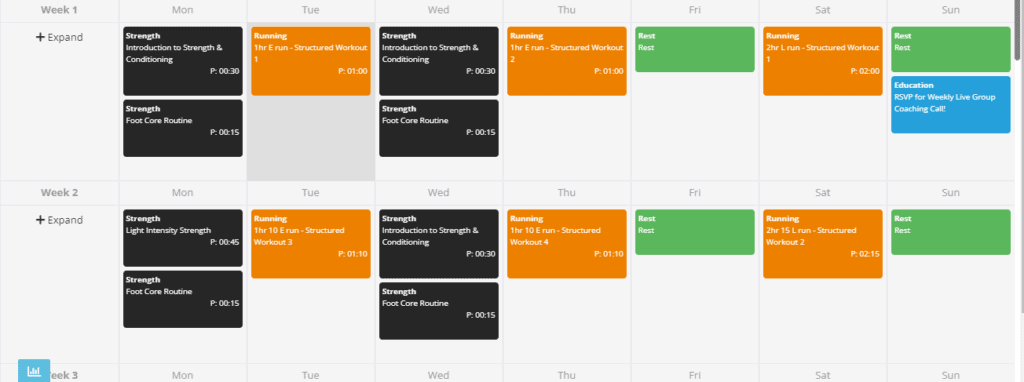If you’re reading this, you’ve likely considered the remarkable challenge of running a marathon. Congratulations on taking that first step!
Whether you’re beginning from a point of little to no running experience or you have some basic running background, this guide is designed to guide you on the journey from novice to conquering the Amsterdam Marathon in the span of just one year.
With the correct training principles, a determined mindset, and the right guidance, it’s entirely feasible to progress from being a beginner runner to successfully running and completing the Amsterdam Marathon within 365 days.
Are you prepared?
To begin, let’s lay down some fundamental principles to serve as your starting point.

First Steps To Marathon Success
1. Set Your Goal
The first thing you need to do is set a clear and achievable goal. You’re about to embark on an exciting journey, so be sure to define why you want to run a marathon.
Maybe it’s to challenge yourself, get healthier, or raise money for a cause you believe in. Having a strong “why” will keep you motivated when the going gets tough.
2. Get the Right Gear
You don’t need the fanciest running gear, but a good pair of running shoes that fit well is essential. They should support and comfort your feet. If you’re not sure, this article will help.
Invest in comfortable, moisture-wicking clothing to prevent chafing and discomfort during long runs.
3. Stay Consistent
Consistency is key! Make a commitment to yourself and stick to your training plan. Find a schedule that works for you and gradually increase the number of days you run each week.
Don’t worry if progress feels slow at first – it’s all part of the journey.
4. Listen to Your Body
Pay close attention to how your body feels. If you experience pain that doesn’t improve with rest, consult a doctor or a sports medicine specialist. It’s essential to address any potential issues early to prevent injuries.
5. Get Your Nutrition Right
Marathon training demands a lot of energy, so it’s essential to focus on consuming an ample amount of carbohydrates. Protein is also crucial to aid your body’s efficient recovery.
I typically suggest sticking to nutritious, whole-food meals as your primary diet during marathon training. Processed foods tend to take longer to digest and often contain additives that might not be the best choice.
How Long Does It Take To Train For Couch To Amsterdam Marathon?
If you stick to a well-structured training plan, you can go from a couch to successfully running the Amsterdam Marathon in about 48 weeks.
This gradual approach not only builds your stamina and endurance but also minimizes the risk of injury, making the goal achievable.
Let’s break down these 48 weeks into manageable stages:
- Weeks 1-12: Going from 0 to 5 km (0 to 3.1 miles). These initial weeks focus on building the stamina to cover this distance.
- Weeks 13-24: Progressing from 5 km to 10 km (3.1 to 6.2 miles). Over the next 12 weeks, the goal is to enhance endurance for this longer distance.
- Weeks 25-36: Advancing from 10 km to 21 km (6.2 to 13.1 miles). In the subsequent 12 weeks, you’ll gradually extend your runs to reach the half-marathon distance.
- Weeks 37-48: Preparing for the full 42 km (26.2 miles) marathon distance. The final 12 weeks are dedicated to getting ready for the ultimate challenge.
The training plans below highlight the significance of the 5K, 10K, and 21K milestones on your journey towards the Amsterdam Marathon.
If you diligently follow each of these training plans in sequence, you can become marathon-ready in slightly less than one year.
Here’s a reliable, science-backed 12-month beginner Amsterdam Marathon training plan.
It not only outlines your daily training sessions but also specifies the appropriate pace for each session to prevent injuries and ensure you’re adequately prepared for race day.
For access to the Couch to Amsterdam Marathon Training Roadmap, click here!
Now, let’s take a closer look at what your training will entail.
What Your Couch To Amsterdam Marathon Training Will Look Like
The key to going from couch to successfully running the Amsterdam Marathon is to gradually build your endurance while prioritizing safety and injury prevention.
The most effective way to do this is by sticking to a personalized training plan that takes into account your age, gender, and current fitness level.
Our training plans, like the one we provide, are designed to systematically increase your running mileage in a safe and efficient manner.
This eliminates the need for you to guess how long or how fast you should run on any given day.
While the paces we recommend may initially seem slow, the goal is to encourage you to run at an easy pace. This approach helps you adapt without risking injury.
To ensure your success, it’s crucial to follow these key principles:
- Strength Training. Incorporating strength training into your routine is vital for reducing the risk of injury.
- Consistency. Staying consistent with your training regimen is key to seeing progress in the coming weeks. Consistency leads to improvement.
It’s important to stick to your training paces. While running faster might feel good, it can work against your overall goals.
This plan requires no expensive equipment and can be done once a week at home.
A Sneak Peek at What Your Couch to Amsterdam Marathon Training Plans Will Look Like


Easy Training Runs
Easy training runs are the cornerstone of increasing your weekly mileage. When we say “EASY,” we really mean it.
During these runs, you should be so comfortable that you can chat effortlessly with a running buddy, and singing a tune should be a breeze without feeling out of breath.
No matter your level or ability, easy runs will always have a place in your training plan, and they become especially important as you progress through your training stages.
So, don’t underestimate the power of these relaxed runs; they’re a key ingredient in your journey to becoming a better runner.
So, Why Do We Do Easy Runs?
1. Recovery
After intense workouts, like those sweaty and challenging sessions, easy runs are like a breath of fresh air for your body.
They give your hardworking muscles a break from high-impact forces and help flush out any waste that builds up during those tough sessions.
2. Aerobic Base Building
Easy runs are the building blocks of your aerobic fitness. They boost your cardiovascular health and enhance your endurance. Here’s how they do it:
- Capillary Growth: These relaxed runs stimulate the growth of capillaries, those tiny blood vessels responsible for delivering oxygen-rich blood to your muscles. More capillaries mean better oxygen supply to your working muscles.
- Mitochondrial Growth: Easy runs also increase the number of mitochondria in your cells. Think of mitochondria as the energy factories of your cells. More of them means your muscles can produce energy more efficiently through oxygen-dependent pathways.
- Improved Oxygen Utilization: Easy runs help your body become a pro at using the available oxygen. This is vital for endurance activities because the better your body can deliver and use oxygen, the longer and stronger you can perform.
3. Mental Break
Besides the physical benefits, easy runs offer a mental escape from the pressures of high-intensity training. They provide an opportunity to enjoy your time on the road or trails without the stress of hitting specific paces or performance goals.
In a nutshell, while easy runs may seem, well, easy, they’re actually working behind the scenes to make you a stronger and more efficient runner.
Rest Days
Rest days are just as vital as your active training days. They provide your body with the precious downtime it needs to adapt and grow stronger.
It’s a fact that many runners often overlook: the benefits of your training sessions manifest during your rest periods, not while you’re actively exercising.
Your body undergoes adaptation and recovery when you’re at rest.
In our training programs, we purposefully schedule rest days to enhance your recovery process. This allows you to smoothly incorporate your training and necessary rest days into your routine.
Consistency isn’t limited to your running or strength training days; it extends to your rest days as well.
Start treating your rest days with the same reverence as your running and strength sessions, recognizing their equal importance.
These rest days give your body the time it needs to recover after intense runs, ultimately enabling you to return to your training sessions better prepared.
Related: A Practical Guide To Running Recovery

Long Runs
Long runs are the beating heart of your training plan. Although they may appear intimidating, they come bearing a treasure trove of benefits.
First and foremost, they’re designed to enhance your stamina and educate your muscles on efficiently tapping into energy reserves, making you better equipped to tackle distances spanning from 5K races to full marathons.
Long runs also contribute significantly to refining your running economy over extended distances.
They play an invaluable role in your mental and physiological preparation for the marathon distance.
Plus, they provide the ideal testing ground for experimenting with different nutrition strategies, helping you pinpoint the best approach for race day.
Among these long runs, the one scheduled 3 to 4 weeks before the marathon stands out as a pivotal moment in your training. It’s a measuring tool for your marathon readiness, fueling a boost of confidence and reinforcing your race-day game plan.
However, there are common mistakes often made by novice runners that you should steer clear of:
- Running Too Fast: Remember, long runs prioritize endurance, not speed. Maintain a comfortable, sustainable pace.
- Rapid Mileage Increases: Avoid the temptation to dramatically increase your weekly mileage. Such haste can lead to overtraining and injuries. Stick to a gradual, safe progression.
- Frequent Breaks: Minimize lengthy breaks during long runs, as they can distort your average pace and create a false sense of ease. Keep the momentum rolling!
Here are 7 INCREDIBLY Simple Ways To BOSS Your Long Run
Strength Training
Strength training tailored for runners is crucial for two primary reasons: injury prevention and enhancing running performance, ultimately making you a faster and more efficient runner.
At Coach Parry, we firmly believe in the significance of strength training, which is why we’ve integrated Strength and Conditioning (S&C) plans into our training program.
While you can find strength training information all over the internet, it’s not just about having a plan; it’s about how you execute it. Proper technique is essential, and our strength and conditioning classes emphasize this aspect.
Equally important is ensuring that your strength training is specifically designed for running and is effective in preventing running-related injuries.
Read more about the importance of strength training here.
Exercises like toe raise and forward & lateral band walks, for example, are perfect. Our free strength training plan is a great place to start and you can download it by clicking here.
Now, let’s take a look at some realistic and attainable goals you should set for yourself…
Setting Couch To Marathon Goals (5K, 10K, 21K)
It’s important to treat the progress from 5K to 10K, 10K to a half marathon, and half marathon to marathon as distinct stages with separate goals.
You have the flexibility to adjust your time goals as you advance through these stages and witness your improvements.
Our training plans incorporate regular time trials every four weeks to help you monitor your progress effectively.
Feel free to pause and allow yourself rest periods between training plans if your body signals the need for it.
It’s perfectly acceptable to maintain your fitness levels through activities like walking, hiking, or cross-training exercises during these breaks.
Avoid rushing through different plans if you don’t feel fully prepared for the transition. Take your time, rest, and consolidate your newfound running fitness before moving forward.
Always prioritize listening to your body throughout this journey. Pushing through minor discomfort can potentially lead to chronic injuries, resulting in less consistent running—something we want to avoid.
Remember, setting realistic goals based on your current fitness level is essential; don’t focus solely on where you want to be.
The Training Plans You Need To Go From Couch To Amsterdam Marathon
View all of the training plans we have discussed above here!
Each of these training plans is designed to provide you with comprehensive support:
Daily Training Sessions:
- Every training session is carefully detailed, guiding you through the precise steps you need to take.
- You’ll find pacing guidelines for every run, ensuring you know exactly how fast to complete them. Our coaches also offer instructional videos to clarify session expectations.
- Adequate recovery periods are factored in, balancing easy runs with interval training, based on the polarized model of training (80/20 principle).
- You’ll have clear instructions on when and for how long your long training runs should be.
Strength Training:
- Regardless of your experience level, our plans cater to everyone, from beginners to seasoned athletes.
- Emphasis is placed on proper technique during these sessions to reduce the risk of injury and guarantee that you’re targeting the right muscle groups.
- We also provide mobility and static stretching plans for your benefit.
- No need for a gym or expensive equipment – everything can be done from the comfort of your home.
Big Picture Planning:
- Get a holistic view of how each training session fits into the overall Amsterdam Marathon Training Roadmap.
- Analyze your training data within the plan to track your progress and responsiveness to the overall training regimen.
What you do leading up to the Amsterdam Marathon will significantly impact your chances of success, so these plans are made to set you up for triumph rather than failure.
How To Stay Motivated For An Entire Year Of Training
Maintaining motivation throughout a year of marathon training can be quite challenging, but it’s absolutely essential for achieving success.
Here are some practical tips to help you stay motivated:
- Run With a Friend or Join a Club: Training with a buddy or becoming part of a local running group can make your workouts more enjoyable and hold you accountable. The camaraderie and support from others can be a powerful motivator.
- Reconnect With Your Why: Reflect on why you embarked on this marathon journey in the first place. Whether it’s personal achievement, better health, or a charitable cause, keeping your purpose at the forefront of your mind can be a strong motivator, especially on tough days.
- Keep a Training Journal: Document your progress, both the ups and downs, in a training journal. Tracking your improvements over time can be incredibly motivating and help you recognize how far you’ve come.
- Visualize Your Goal: Close your eyes and visualize yourself triumphantly crossing the Amsterdam Marathon finish line. Visualization can help you stay focused and motivated, especially during grueling training sessions.
- Mix It Up: Avoid falling into a monotonous routine. Change your training routes, try new paths, and try different workouts or cross-training activities to keep things fresh and interesting.
- Reward Yourself: Break your year-long training into smaller milestones and reward yourself when you reach them. It could be a new piece of running gear, your favorite treat, or a relaxing massage. These rewards can serve as powerful incentives.
- Stay Flexible: While consistency is vital, flexibility is equally important. Life can throw unexpected challenges your way. Be open to adjusting your training plan when necessary instead of becoming discouraged by setbacks.
- Celebrate Small Wins: Don’t wait until the marathon itself to celebrate your achievements. Recognize and celebrate small victories along the way. Each milestone you reach is a step closer to your ultimate goal.
- Seek Inspiration: Draw inspiration from other runners’ journeys, read uplifting stories, or watch motivational videos. Sometimes, witnessing others overcome obstacles can reignite your own motivation.
- Remember It’s Okay to Rest: Pushing yourself relentlessly without allowing for proper rest can lead to burnout. Rest is an integral part of effective training. Embrace it and let your body and mind recover.

Beginner Tips To Go From Couch To Amsterdam Marathon
Here are some essential tips to keep in mind as you prepare for the Amsterdam Marathon:
- Cross Train: Don’t limit yourself to just running. Incorporate activities like swimming, cycling, or yoga into your fitness routine. This not only keeps your workouts interesting but also helps prevent injuries by engaging different muscle groups.
- Prioritize Sleep: Quality sleep is crucial for runners as it’s when your body repairs and strengthens. Ensure you get enough rest to support your training efforts.
- Easy Runs: Learn to pace your easy runs appropriately. These form the foundation of your training and should be comfortable. Avoid pushing too hard during these sessions to prevent overexertion.
- Nutrition Matters: Pay close attention to your nutrition. Proper food and hydration are essential to maintain your energy levels and aid in recovery. Familiarize yourself with nutrition tailored to runners’ needs.
- Stick to Your Plan: Consistency is key. Strive to follow your training plan as closely as possible. Consistent training is what builds your stamina for the big race day.
- Incorporate Strength Training: Include strength training in your regimen to protect yourself from injuries. This targets small muscles crucial for balance and support. Follow a strength plan specifically designed for runners.
- Secure Your Race Spot: Registering for the Amsterdam Marathon can be competitive. Plan ahead and ensure you secure your spot in the event.
- Book Accommodations Early: Consider booking your accommodations well in advance, up to a year ahead if possible. Here you’ll find places that are closer to the start line: Amsterdam Marathon: The BEST Views To Watch Along The Route
By following these guidelines, you’ll be better prepared for the Amsterdam Marathon and increase your chances of a successful and enjoyable race day. Good luck with your training and the race itself!
Related: A COMPLETE Guide to Amsterdam Marathon Expo: Must-Know Info



Comments are closed.